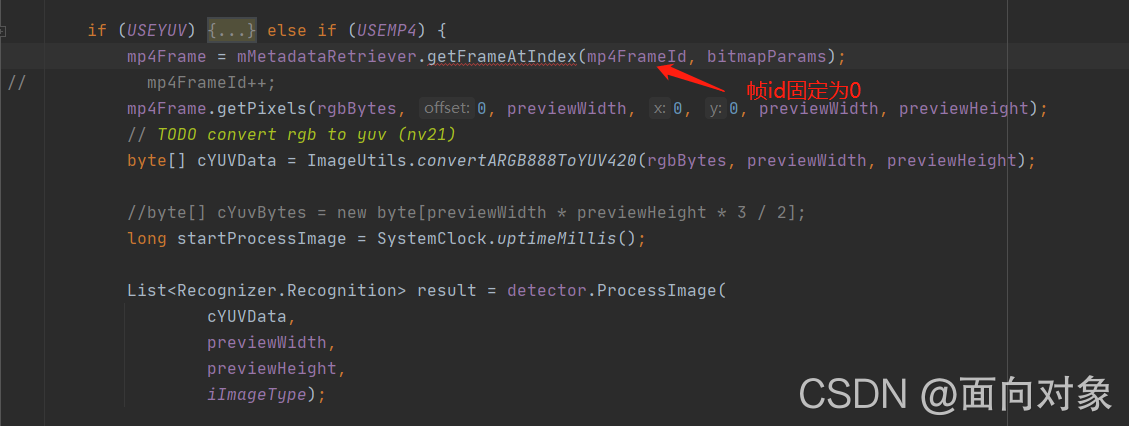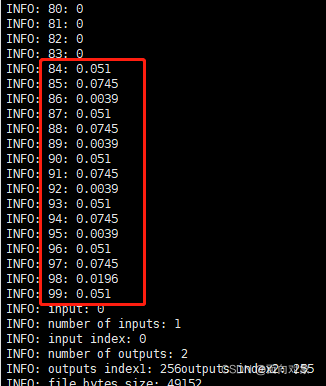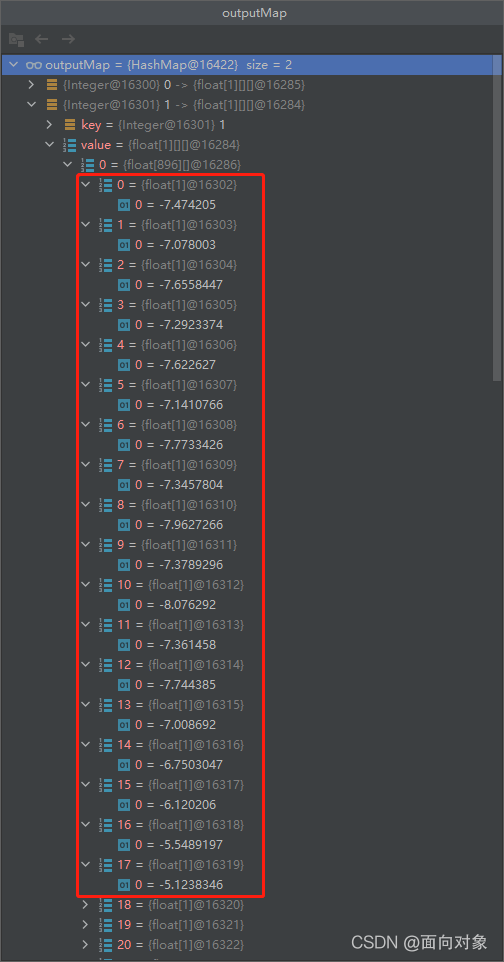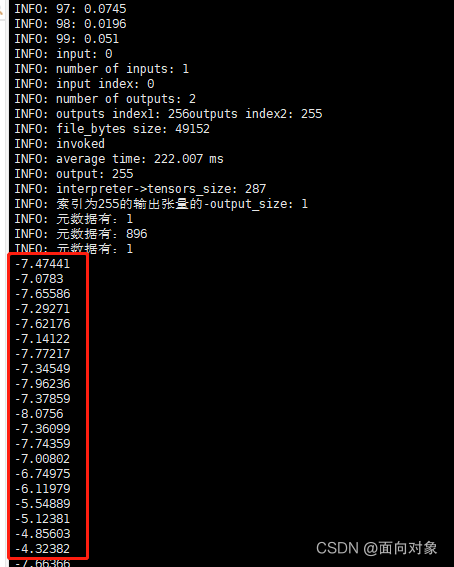您好,登錄后才能下訂單哦!
您好,登錄后才能下訂單哦!
這篇文章主要介紹“C++中TensorflowLite模型驗證的過程”,在日常操作中,相信很多人在C++中TensorflowLite模型驗證的過程問題上存在疑惑,小編查閱了各式資料,整理出簡單好用的操作方法,希望對大家解答”C++中TensorflowLite模型驗證的過程”的疑惑有所幫助!接下來,請跟著小編一起來學習吧!
故事是這樣的:
有一個手撐檢測的tflite模型,需要在開發板上跑起來。手機版本的已成熟,要移植到開發板上。現在要驗證tflite模型文件在板子上的運行結果要和手機上一致。
前提:為了多次重復測試,在Android端使用了同一幀數據(從一個錄制的mp4中固定取一張圖)測試代碼如下圖

下面是測試過程
記錄下Android版API運行推理前的圖片數據文件(經過了規一化處理,所以都是-1~1之間的float數據)

這一步卡在了寫float數據到二進制文件中,C++讀出來有問題換了個方案,直接存儲float字符串
private void saveFile(float[] pfImageData) {
try {
File file = new File(Environment.getExternalStoragePublicDirectory(Environment.DIRECTORY_DOWNLOADS).getAbsolutePath() + "/tfimg");
StringBuilder sb = new StringBuilder();
for (float val : pfImageData) {
//保留4位小數,這里可以改為其他值
sb.append(String.format("%.4f", val));
sb.append("\r\n");
}
FileWriter out = new FileWriter(file); //文件寫入流
out.write(sb.toString());
out.close();
} catch (Exception e) {
e.printStackTrace();
Log.e("Melon", "存儲文件異常," + e.getMessage());
}
}拿著這個文件在板子上輸入到Tflite模型中
測試代碼,主要是RunInference()和read_file()
/* Copyright 2017 The TensorFlow Authors. All Rights Reserved.
Licensed under the Apache License, Version 2.0 (the "License");
you may not use this file except in compliance with the License.
You may obtain a copy of the License at
http://www.apache.org/licenses/LICENSE-2.0
Unless required by applicable law or agreed to in writing, software
distributed under the License is distributed on an "AS IS" BASIS,
WITHOUT WARRANTIES OR CONDITIONS OF ANY KIND, either express or implied.
See the License for the specific language governing permissions and
limitations under the License.
==============================================================================*/
#include "tensorflow/lite/examples/label_image/label_image.h"
#include <fcntl.h> // NOLINT(build/include_order)
#include <getopt.h> // NOLINT(build/include_order)
#include <sys/time.h> // NOLINT(build/include_order)
#include <sys/types.h> // NOLINT(build/include_order)
#include <sys/uio.h> // NOLINT(build/include_order)
#include <unistd.h> // NOLINT(build/include_order)
#include <cstdarg>
#include <cstdio>
#include <cstdlib>
#include <fstream>
#include <iomanip>
#include <iostream>
#include <map>
#include <memory>
#include <sstream>
#include <string>
#include <unordered_set>
#include <vector>
#include "absl/memory/memory.h"
#include "tensorflow/lite/examples/label_image/bitmap_helpers.h"
#include "tensorflow/lite/examples/label_image/get_top_n.h"
#include "tensorflow/lite/examples/label_image/log.h"
#include "tensorflow/lite/kernels/register.h"
#include "tensorflow/lite/optional_debug_tools.h"
#include "tensorflow/lite/profiling/profiler.h"
#include "tensorflow/lite/string_util.h"
#include "tensorflow/lite/tools/command_line_flags.h"
#include "tensorflow/lite/tools/delegates/delegate_provider.h"
namespace tflite
{
namespace label_image
{
double get_us(struct timeval t) { return (t.tv_sec * 1000000 + t.tv_usec); }
using TfLiteDelegatePtr = tflite::Interpreter::TfLiteDelegatePtr;
using ProvidedDelegateList = tflite::tools::ProvidedDelegateList;
class DelegateProviders
{
public:
DelegateProviders() : delegate_list_util_(¶ms_)
{
delegate_list_util_.AddAllDelegateParams();
}
// Initialize delegate-related parameters from parsing command line arguments,
// and remove the matching arguments from (*argc, argv). Returns true if all
// recognized arg values are parsed correctly.
bool InitFromCmdlineArgs(int *argc, const char **argv)
{
std::vector<tflite::Flag> flags;
// delegate_list_util_.AppendCmdlineFlags(&flags);
const bool parse_result = Flags::Parse(argc, argv, flags);
if (!parse_result)
{
std::string usage = Flags::Usage(argv[0], flags);
LOG(ERROR) << usage;
}
return parse_result;
}
// According to passed-in settings `s`, this function sets corresponding
// parameters that are defined by various delegate execution providers. See
// lite/tools/delegates/README.md for the full list of parameters defined.
void MergeSettingsIntoParams(const Settings &s)
{
// Parse settings related to GPU delegate.
// Note that GPU delegate does support OpenCL. 'gl_backend' was introduced
// when the GPU delegate only supports OpenGL. Therefore, we consider
// setting 'gl_backend' to true means using the GPU delegate.
if (s.gl_backend)
{
if (!params_.HasParam("use_gpu"))
{
LOG(WARN) << "GPU deleate execution provider isn't linked or GPU "
"delegate isn't supported on the platform!";
}
else
{
params_.Set<bool>("use_gpu", true);
// The parameter "gpu_inference_for_sustained_speed" isn't available for
// iOS devices.
if (params_.HasParam("gpu_inference_for_sustained_speed"))
{
params_.Set<bool>("gpu_inference_for_sustained_speed", true);
}
params_.Set<bool>("gpu_precision_loss_allowed", s.allow_fp16);
}
}
// Parse settings related to NNAPI delegate.
if (s.accel)
{
if (!params_.HasParam("use_nnapi"))
{
LOG(WARN) << "NNAPI deleate execution provider isn't linked or NNAPI "
"delegate isn't supported on the platform!";
}
else
{
params_.Set<bool>("use_nnapi", true);
params_.Set<bool>("nnapi_allow_fp16", s.allow_fp16);
}
}
// Parse settings related to Hexagon delegate.
if (s.hexagon_delegate)
{
if (!params_.HasParam("use_hexagon"))
{
LOG(WARN) << "Hexagon deleate execution provider isn't linked or "
"Hexagon delegate isn't supported on the platform!";
}
else
{
params_.Set<bool>("use_hexagon", true);
params_.Set<bool>("hexagon_profiling", s.profiling);
}
}
// Parse settings related to XNNPACK delegate.
if (s.xnnpack_delegate)
{
if (!params_.HasParam("use_xnnpack"))
{
LOG(WARN) << "XNNPACK deleate execution provider isn't linked or "
"XNNPACK delegate isn't supported on the platform!";
}
else
{
params_.Set<bool>("use_xnnpack", true);
params_.Set<bool>("num_threads", s.number_of_threads);
}
}
}
// Create a list of TfLite delegates based on what have been initialized (i.e.
// 'params_').
std::vector<ProvidedDelegateList::ProvidedDelegate> CreateAllDelegates()
const
{
return delegate_list_util_.CreateAllRankedDelegates();
}
private:
// Contain delegate-related parameters that are initialized from command-line
// flags.
tflite::tools::ToolParams params_;
// A helper to create TfLite delegates.
ProvidedDelegateList delegate_list_util_;
};
// Takes a file name, and loads a list of labels from it, one per line, and
// returns a vector of the strings. It pads with empty strings so the length
// of the result is a multiple of 16, because our model expects that.
// std::vector<uint8_t> read_file(const std::string &input_bmp_name)
// {
// int begin, end;
// std::ifstream file(input_bmp_name, std::ios::in | std::ios::binary);
// if (!file)
// {
// LOG(FATAL) << "input file " << input_bmp_name << " not found";
// exit(-1);
// }
// begin = file.tellg();
// file.seekg(0, std::ios::end);
// end = file.tellg();
// size_t len = end - begin;
// LOG(INFO) << "len: " << len;
// std::vector<uint8_t> img_bytes(len);
// file.seekg(0, std::ios::beg);
// file.read(reinterpret_cast<char *>(img_bytes.data()), len);
// return img_bytes;
// }
/**
* 讀取文件
*/
std::vector<float> read_file(const std::string &input_bmp_name)
{
int begin, end;
std::ifstream file(input_bmp_name, std::ios::in | std::ios::binary);
if (!file)
{
LOG(FATAL) << "input file " << input_bmp_name << " not found";
exit(-1);
}
begin = file.tellg();
file.seekg(0, std::ios::end);
end = file.tellg();
size_t len = end - begin;
LOG(INFO) << "len: " << len;
std::vector<float> img_bytes;
file.seekg(0, std::ios::beg);
string strLine = "";
float temp;
while (getline(file, strLine))
{
temp = atof(strLine.c_str());
img_bytes.push_back(temp);
}
LOG(INFO) << "文件讀取完成:" << input_bmp_name;
return img_bytes;
}
/**
* 運行推理
*/
void RunInference(Settings *settings)
{
if (!settings->model_name.c_str())
{
LOG(ERROR) << "no model file name";
exit(-1);
}
std::unique_ptr<tflite::FlatBufferModel> model;
std::unique_ptr<tflite::Interpreter> interpreter;
model = tflite::FlatBufferModel::BuildFromFile(settings->model_name.c_str());
if (!model)
{
LOG(ERROR) << "Failed to mmap model " << settings->model_name;
exit(-1);
}
settings->model = model.get();
LOG(INFO) << "Loaded model " << settings->model_name;
model->error_reporter();
LOG(INFO) << "resolved reporter";
tflite::ops::builtin::BuiltinOpResolver resolver;
tflite::InterpreterBuilder(*model, resolver)(&interpreter); //生成interpreter
if (!interpreter)
{
LOG(ERROR) << "Failed to construct interpreter";
exit(-1);
}
interpreter->SetAllowFp16PrecisionForFp32(settings->allow_fp16);
if (settings->verbose)
{
LOG(INFO) << "tensors size: " << interpreter->tensors_size();
LOG(INFO) << "nodes size: " << interpreter->nodes_size();
LOG(INFO) << "inputs: " << interpreter->inputs().size();
LOG(INFO) << "input(0) name: " << interpreter->GetInputName(0);
int t_size = interpreter->tensors_size();
for (int i = 0; i < t_size; i++)
{
if (interpreter->tensor(i)->name)
LOG(INFO) << i << ": " << interpreter->tensor(i)->name << ", "
<< interpreter->tensor(i)->bytes << ", "
<< interpreter->tensor(i)->type << ", "
<< interpreter->tensor(i)->params.scale << ", "
<< interpreter->tensor(i)->params.zero_point;
}
}
if (settings->number_of_threads != -1)
{
interpreter->SetNumThreads(settings->number_of_threads);
}
int image_width = 128;
int image_height = 128;
int image_channels = 3;
// std::vector<uint8_t> in = read_bmp(settings->input_bmp_name, &image_width, &image_height, &image_channels, settings);
std::vector<float> file_bytes = read_file(settings->input_bmp_name);
for (int i = 0; i < 100; i++)
{
//和Android的輸入做對比
LOG(INFO) << i << ": " << file_bytes[i];
}
/* inputs()[0]得到輸入張量數組中的第一個張量,也就是classifier中唯一的那個輸入張量;
input是個整型值,是張量列表中的引索 */
int input = interpreter->inputs()[0];
LOG(INFO) << "input: " << input;
const std::vector<int> inputs = interpreter->inputs();
const std::vector<int> outputs = interpreter->outputs();
LOG(INFO) << "number of inputs: " << inputs.size();
LOG(INFO) << "input index: " << inputs[0];
LOG(INFO) << "number of outputs: " << outputs.size();
LOG(INFO) << "outputs index1: " << outputs[0] << ",outputs index2: " << outputs[1];
if (interpreter->AllocateTensors() != kTfLiteOk)
{ //加載所有tensor
LOG(ERROR) << "Failed to allocate tensors!";
exit(-1);
}
if (settings->verbose)
PrintInterpreterState(interpreter.get());
// 從輸入張量的原數據中得到輸入尺寸
TfLiteIntArray *dims = interpreter->tensor(input)->dims;
int wanted_height = dims->data[1];
int wanted_width = dims->data[2];
int wanted_channels = dims->data[3];
settings->input_type = interpreter->tensor(input)->type;
//typed_tensor返回一個經過固定數據類型轉換的tensor指針
//以input為索引,在TfLiteTensor* content_.tensors這個張量表得到具體的張量
//返回該張量的data.raw,它指示張量正關聯著的內存塊
// resize<float>(interpreter->typed_tensor<float>(input), in.data(),
// image_height, image_width, image_channels, wanted_height,
// wanted_width, wanted_channels, settings);
//賦值給input tensor
float *inputP = interpreter->typed_input_tensor<float>(0);
LOG(INFO) << "file_bytes size: " << file_bytes.size();
for (int i = 0; i < file_bytes.size(); i++)
{
inputP[i] = file_bytes[i];
}
struct timeval start_time, stop_time;
gettimeofday(&start_time, nullptr);
for (int i = 0; i < settings->loop_count; i++)
{ //調用模型進行推理
if (interpreter->Invoke() != kTfLiteOk)
{
LOG(ERROR) << "Failed to invoke tflite!";
exit(-1);
}
}
gettimeofday(&stop_time, nullptr);
LOG(INFO) << "invoked";
LOG(INFO) << "average time: "
<< (get_us(stop_time) - get_us(start_time)) /
(settings->loop_count * 1000)
<< " ms";
const float threshold = 0.001f;
int output = interpreter->outputs()[1];
LOG(INFO) << "output: " << output;
LOG(INFO) << "interpreter->tensors_size: " << interpreter->tensors_size();
TfLiteTensor *tensor = interpreter->tensor(output);
TfLiteIntArray *output_dims = tensor->dims;
// assume output dims to be something like (1, 1, ... ,size)
auto output_size = output_dims->data[output_dims->size - 1];
LOG(INFO) << "索引為" << output << "的輸出張量的-"
<< "output_size: " << output_size;
for (int i = 0; i < output_dims->size; i++)
{
LOG(INFO) << "元數據有:" << output_dims->data[i];
}
float *prediction = interpreter->typed_output_tensor<float>(1);
float classificators[1][896][1];
memcpy(classificators, prediction, 896 * 1 * sizeof(float));
// float classificators[1][896][18];
// memcpy(classificators, prediction, 896 * 18 * sizeof(float));
//輸出分類結果
for (float(&r)[896][1] : classificators)
{
for (float(&p)[1] : r)
{
for (float &q : p)
{
std::cout << q << ' ';
}
std::cout << std::endl;
}
std::cout << std::endl;
}
}
int Main(int argc, char **argv)
{
DelegateProviders delegate_providers;
bool parse_result = delegate_providers.InitFromCmdlineArgs(
&argc, const_cast<const char **>(argv));
if (!parse_result)
{
return EXIT_FAILURE;
}
Settings s;
int c;
while (true)
{
static struct option long_options[] = {
{"accelerated", required_argument, nullptr, 'a'},
{"allow_fp16", required_argument, nullptr, 'f'},
{"count", required_argument, nullptr, 'c'},
{"verbose", required_argument, nullptr, 'v'},
{"image", required_argument, nullptr, 'i'},
{"labels", required_argument, nullptr, 'l'},
{"tflite_model", required_argument, nullptr, 'm'},
{"profiling", required_argument, nullptr, 'p'},
{"threads", required_argument, nullptr, 't'},
{"input_mean", required_argument, nullptr, 'b'},
{"input_std", required_argument, nullptr, 's'},
{"num_results", required_argument, nullptr, 'r'},
{"max_profiling_buffer_entries", required_argument, nullptr, 'e'},
{"warmup_runs", required_argument, nullptr, 'w'},
{"gl_backend", required_argument, nullptr, 'g'},
{"hexagon_delegate", required_argument, nullptr, 'j'},
{"xnnpack_delegate", required_argument, nullptr, 'x'},
{nullptr, 0, nullptr, 0}};
/* getopt_long stores the option index here. */
int option_index = 0;
c = getopt_long(argc, argv,
"a:b:c:d:e:f:g:i:j:l:m:p:r:s:t:v:w:x:", long_options,
&option_index);
/* Detect the end of the options. */
if (c == -1)
break;
switch (c)
{
case 'a':
s.accel = strtol(optarg, nullptr, 10); // NOLINT(runtime/deprecated_fn)
break;
case 'b':
s.input_mean = strtod(optarg, nullptr);
break;
case 'c':
s.loop_count =
strtol(optarg, nullptr, 10); // NOLINT(runtime/deprecated_fn)
break;
case 'e':
s.max_profiling_buffer_entries =
strtol(optarg, nullptr, 10); // NOLINT(runtime/deprecated_fn)
break;
case 'f':
s.allow_fp16 =
strtol(optarg, nullptr, 10); // NOLINT(runtime/deprecated_fn)
break;
case 'g':
s.gl_backend =
strtol(optarg, nullptr, 10); // NOLINT(runtime/deprecated_fn)
break;
case 'i':
s.input_bmp_name = optarg;
break;
case 'j':
s.hexagon_delegate = optarg;
break;
case 'l':
s.labels_file_name = optarg;
break;
case 'm':
s.model_name = optarg;
break;
case 'p':
s.profiling =
strtol(optarg, nullptr, 10); // NOLINT(runtime/deprecated_fn)
break;
case 'r':
s.number_of_results =
strtol(optarg, nullptr, 10); // NOLINT(runtime/deprecated_fn)
break;
case 's':
s.input_std = strtod(optarg, nullptr);
break;
case 't':
s.number_of_threads = strtol( // NOLINT(runtime/deprecated_fn)
optarg, nullptr, 10);
break;
case 'v':
s.verbose =
strtol(optarg, nullptr, 10); // NOLINT(runtime/deprecated_fn)
break;
case 'w':
s.number_of_warmup_runs =
strtol(optarg, nullptr, 10); // NOLINT(runtime/deprecated_fn)
break;
case 'x':
s.xnnpack_delegate =
strtol(optarg, nullptr, 10); // NOLINT(runtime/deprecated_fn)
break;
case 'h':
case '?':
/* getopt_long already printed an error message. */
exit(-1);
default:
exit(-1);
}
}
delegate_providers.MergeSettingsIntoParams(s);
RunInference(&s);
return 0;
}
} // namespace label_image
} // namespace tflite
int main(int argc, char **argv)
{
return tflite::label_image::Main(argc, argv);
}運行指令 ./ws_app --tflite_model libnewpalm_detection.tflite --image tfimg對比推理前的輸入一致
Android端

開發板上

對比推理后的輸出一致 Android端

開發板端

到此,關于“C++中TensorflowLite模型驗證的過程”的學習就結束了,希望能夠解決大家的疑惑。理論與實踐的搭配能更好的幫助大家學習,快去試試吧!若想繼續學習更多相關知識,請繼續關注億速云網站,小編會繼續努力為大家帶來更多實用的文章!
免責聲明:本站發布的內容(圖片、視頻和文字)以原創、轉載和分享為主,文章觀點不代表本網站立場,如果涉及侵權請聯系站長郵箱:is@yisu.com進行舉報,并提供相關證據,一經查實,將立刻刪除涉嫌侵權內容。